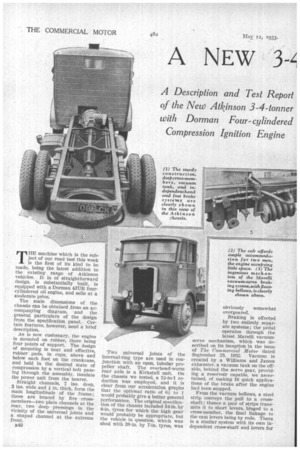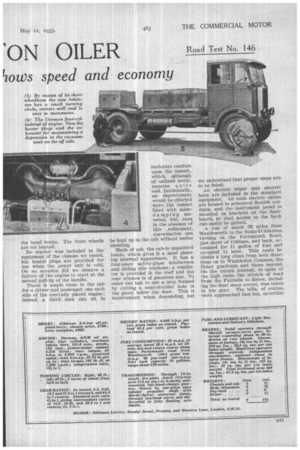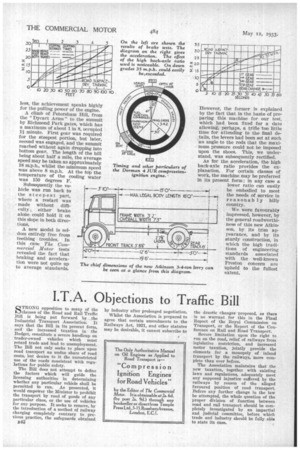AN EW 3z 1 0N OILER rio ws speed and economy
Page 58

Page 59

Page 60

If you've noticed an error in this article please click here to report it so we can fix it.
THE machine which is the subject of our road test this week is the first of its kind to be made, being the latest addition to the existing range of Atkinson vehicles. It is. of straightforward design, is substantially built, is equipped with a Dorman 4JUR fourcylindered oil engine, and sells at a moderate price.
The main dimensions of the chassis can be obtained from an accompanying diagram, and the general particulars of the design from the specification panel. Certain features, however, need a brief description.
As is now customary, the engine is mounted on rubber, there being four points of support. The design of mounting is neat and effective, rubber pads, in cups, above and below each foot on the crankcase, and held in the desired state of compression by a vertical bolt passing through the assembly, insulate the power unit from the bearer.
Straight channels, 7 ins. deep, .3 ins, wide and i in. thick, form the main longitudinals of the frame; these are braced by five -crossmembers—two plain channels at the rear, two deep pressings in the vicinity of the universal joints and a shaped channel at the extreme front.
B40 Two universal joints of the internal-ring type are used in conjunction with an open, tubular propeller shaft. The overhead-worm rear axle is a Kirkstall unit. On the chassis we tested, a 51-to-1 reduction was employed, and it is clear from our acceleration graphs that the optional ratio of 61 to 1 would probably give a better general performance. The original specification of the chassis included 34-in. by 6-in. tyres for which the high gear would probably be appropriate, but the vehicle in question, which was shod with 38-iu. by 7-in. tyres, was
(2) The cab affords ample accommodation for two men, the engine occupying little space. (3) The ingenious mechanism, of the MarelIi vacuum-servo braking system ,with floating bellows, is clearly
shown above.
obviously somewhat o vergea red.
Braking is effected by two entirely separate systems; the pedal operates through the latest Marelli vacuumservo mechanism, which was described on its inception in the issue of The Commercial Motor dated September 23, 1932. Vacuum is created by a Williams and James exhauster, a vacuum tank on the offside, behind the servo gear, providing a reservoir capable, we ascertained, of making 16 quick applications of the brake after the engine had been stopped.
From the vacuum bellows, a steel strip conveys the pull to a crossshaft ; thence a pair of strips transmits it to short levers, hinged to a cross-member, the final linkage to the cain levers being by rods. There is a similar system with its own independent cross-shaft and levers for the band brake. The front wheels are not braked.
No starter was included in the equipment of the chassis we tested, but heater plugs are provided for use when the power unit is cold. On no occasion did we observe a failure of the engine to start at the second pull-up of the handle.
There is ample room in the cab for a driver and passenger, one each side of the centrally placed engine; Indeed, a third man can sit in moderate comfort upon the bonnet, which, although of 'unlined metal, remains quit e cool. Incidentally, an improvement would be effected were the bonnet lined with noisedamping material, but, even in the absence of this .refinement, conversation can be kept up in the cab without undue shouting. Made of ash, the cab-is unpainted inside, which gives it a most pleasing internal appearance. It has a four-pie.ce safety-glass windscreen and sliding side windows ; a ventilator is provided in the roof and the rear window is of generous size. To enter one has to use a step formed by cutting a semi-circular hole in the panel below the door. This is inconvenient when descending, but we understand that proper steps are to be fitted.
An electric wiper and electric horn are included in the standard equipment.. All main electric cables are housed in armoured flexible conduits, and the instrument panel is mounted on brackets on the dashboard, so that access to the back can easily be gained.
A run of about ,33 miles from Wandsworth to the Stoke-IYAbernon turning on the Portsmouth Road, just short Of Cobham, and back, accounted for 14 gallon of fuel and occupied 11 hour. This route includes a long climb from both directions on to Wimbledon Common, the Esher gradients and those beyond. On the return journey, in spite of the high ratio, the stretch of road from the Fairmile to Esher, including the final steep ascent, was taken in top gear. The hills, of course. were approached fast but, neverthe
less, the achievement speaks highly for the pulling power of the engine.
A climb of Petersham Hill, from the " Dycart Arms" to the summit by Richmond Park gates, which has a maximum of about 1 in 8, occupied 11 minute. First gear was required for the steepest portion, but later, second was engaged, and the summit reached without again dropping into bottom gear. The length of the hill being about half a mile, the average speed may be taken as approximately 18 m.p.h., whilst the minimum speed was above 8 m.p.h. At the top the temperature of the cooling water was 150 degrees P.
Subsequently the vehicle was run back to the steepest part, where a restart was
• made without difficulty; either brake alone could hold it on this slope in both directions,
A new model is seldom entirely free. from teething troubles. In this case The Commercial Motor tests revealed the fact that braking and acceleration were not quite up to average standards.
However, the former is explained by the fact that in the haste of preparing this machine for our test, which had been fixed for a date allowing, perhaps, a trifle too little time for attending to the final details, the levers had been set at such an angle to the rods that the maximum pressure could not be imposed upon the shoes. This, we understand, was subsequently rectified.
As for the acceleration, the high back-axle ratio provides the explanation. For certain classes of work, the machine may be preferred in its present form; in any case a lower ratio can easily be embodied to meet the needs of service in reasonably hilly .country.
1 I
We were favourably impressed, however, by the general roadworthiness of this new Atkinson, by its trim appearance, and by its sturdy construction, in which the high traditions of engineering standards associated with the well-known Preston concern are upheld to the fullest extent.




































































































